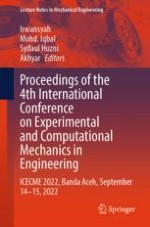This book gathers a selection of peer-reviewed papers presented at the 4th International Conference on Experimental and Computational Mechanics in Engineering (ICECME 2022), held as a virtual conference and organized by Universitas Syiah Kuala, Banda Aceh, Indonesia, on September 14–15, 2022.
This book, prepared by international scientists and engineers, covers the latest advances in computational mechanics, metallurgy and material science, energy systems, manufacturing processing systems, industrial and system engineering, biomechanics, artificial intelligence, micro-/nano-engineering, micro-electro-mechanical system, machine learning, mechatronics, and engineering design. This book is intended for academics, including graduate students and researchers, as well as industrial practitioners working in the areas of experimental and computational mechanics.
